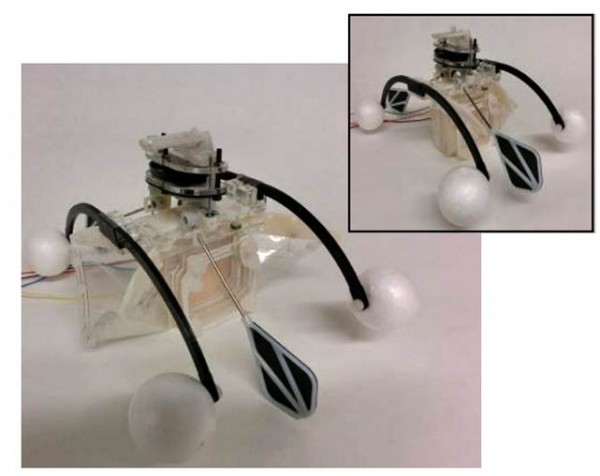Aquatic Robot “Eats” Microbes in Water to Generate Electricity
| Arthur Dominic Villasanta | | Oct 31, 2016 09:38 AM EDT |
(Photo : Bristol Robotics Laboratory ) Row-bot with mouth open (inset shows mouth closed).
Researchers at the Bristol Robotics Laboratory in the United Kingdom have developed an aquatic robot that generates the electricity it needs to power itself by "eating" microscopic microbes ever present in water. The dirtier the water, the more power it produces.
The swimming robot named "Row-bot" uses microbes as fuel for its Microbial Fuel Cell (MFC) that generate electricity. The MFC is located in Row-bot's "stomach," which has a "mouth" that opens to swallow water. Row-bot moves forward using two paddles attached to its sides.
Like Us on Facebook
Microbes emit electrons as a by-product of eating even smaller organisms. Row-bot takes advantage of this natural function to generate power by harvesting these electrons.
Each time Row-bot opens its mouth, it swims forward by 10 strokes at a speed of one stroke per second. As it moves forward, the machine channels water into the MFC in its stomach and digests the water for three minutes.
Row-bot expels the water out its back side as it swims forward again. It then repeats this cycle.
Row-bot stores the energy generated by the MFC in a capacitor. Over one cycle (opening its mouth, swimming and then closing its mouth), it only uses 1.8 joules.
That's 20 centimeters of motion with about 1 joule of energy leftover that could be used to power sensors or laser turrets or something.
As long as Row-bot swims, the MFC makes it "energetically autonomous."
Bristol researchers said Row-bot's MFCs work in all kinds of water. This includes fresh water in rivers and lakes, seawater and even waste water. As an added benefit, Row-bots clean the water as they swim along it eating microbes along the way.
Row-bot's prototype is a testbed for integration of the MFC with actuators to see how well it works.
Researchers said there's a lot more optimization required, like reducing body drag and finding the most efficient combination of materials to use for the paddles. They also believe multiple MFCs could be configured in series to generate more power.
They feel Row-bot could be developed for applications such as remote sensing and environmental monitoring and clean-up.
TagsRow-bot, Bristol Robotics Laboratory, Microbes, water, swims
©2015 Chinatopix All rights reserved. Do not reproduce without permission
 China now World Leader in Industrial Robot Production; also Leads in ‘Service Robotics’
China now World Leader in Industrial Robot Production; also Leads in ‘Service Robotics’ DARPA Robot Submarine Killer Warship called ACTUV gets a ‘Spy in the Sky’
DARPA Robot Submarine Killer Warship called ACTUV gets a ‘Spy in the Sky’ London Conference to Titillate with Talks about Robot Sex and ‘Sexbots’
London Conference to Titillate with Talks about Robot Sex and ‘Sexbots’ Study Examines how Artificial Intelligence Might Affect Urban Life in 2030
Study Examines how Artificial Intelligence Might Affect Urban Life in 2030
EDITOR'S PICKS
-

Did the Trump administration just announce plans for a trade war with ‘hostile’ China and Russia?
-

US Senate passes Taiwan travel bill slammed by China
-

As Yan Sihong’s family grieves, here are other Chinese students who went missing abroad. Some have never been found
-

Beijing blasts Western critics who ‘smear China’ with the term sharp power
-

China Envoy Seeks to Defuse Tensions With U.S. as a Trade War Brews
-

Singapore's Deputy PM Provides Bitcoin Vote of Confidence Amid China's Blanket Bans
-

China warns investors over risks in overseas virtual currency trading
-

Chinese government most trustworthy: survey
-

Kashima Antlers On Course For Back-To-Back Titles
MOST POPULAR
LATEST NEWS
Zhou Yongkang: China's Former Security Chief Sentenced to Life in Prison

China's former Chief of the Ministry of Public Security, Zhou Yongkang, has been given a life sentence after he was found guilty of abusing his office, bribery and deliberately ... Full Article
TRENDING STORY

China Pork Prices Expected to Stabilize As The Supplies Recover

Elephone P9000 Smartphone is now on Sale on Amazon India

There's a Big Chance Cliffhangers Won't Still Be Resolved When Grey's Anatomy Season 13 Returns

Supreme Court Ruled on Samsung vs Apple Dispute for Patent Infringement

Microsoft Surface Pro 5 Rumors and Release Date: What is the Latest?










